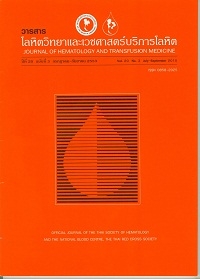ภาวะไข้จากเม็ดเลือดขาวต่ำของผู้ป่วยหลังการรักษาด้วยยาเคมีบำบัด ในแผนกอายุรกรรม โรงพยาบาลธรรมศาสตร์เฉลิมพระเกียรติ
Keywords:
ไข้จากเม็ดเลือดขาวต่ำ, เคมีบำบัด, มะเร็ง, Febrile neutropenia, Cancer, ChemotherapyAbstract
บทคัดย่อ
ความเป็นมา : ภาวะไข้จากเม็ดเลือดขาวต่ำภายหลังการได้รับยาเคมีบำบัดนำมาซึ่งการสูญเสียทรัพยากรทางสาธารณสุขเป็นอย่างมาก ปัจจุบันยังไม่มีการทำนายโอกาสการเกิดภาวะดังกล่าวที่ง่ายและสามารถนำไปใช้ได้จริงในชีวิตประจำวันในโรงพยาบาลธรรมศาสตร์เฉลิมพระเกียรติได้ วัตถุประสงค์ : เพื่อศึกษาอุบัติการณ์และลักษณะทางคลินิกของภาวะไข้จากเม็ดเลือดขาวต่ำ ภายหลังการได้รับยาเคมีบำบัดในแผนกอายุรกรรม โรงพยาบาลธรรมศาสตร์เฉลิมพระเกียรติ วิธีการศึกษา : การเฝ้าสังเกตการณ์ชนิดไปข้างหน้าและย้อนหลังในช่วงเวลาหนึ่ง ผลการศึกษา : ในช่วงการศึกษา 18 เดือน (1 มกราคม 2551 ถึง 30 มิถุนายน 2552) พบว่ามีผู้ป่วยเกิดภาวะไข้จากเม็ดเลือดขาวต่ำภายหลังการได้รับยาเคมีบำบัดทั้งสิ้น 35 ราย รวม 62 เหตุการณ์ โดยเฉลี่ย 2 รายต่อเดือน หรือประมาณ 3 เหตุการณ์ต่อเดือน ผู้ป่วยชายและหญิงจำนวนใกล้เคียงกัน (ชายร้อยละ 56 หญิงร้อยละ 44) ผู้ป่วยกลุ่มอายุ 41-50 ปี (ร้อยละ 26) และผู้ป่วยที่มี ECOG score เท่ากับ 0 (ร้อยละ 34) มีโอกาสการเกิดภาวะดังกล่าวได้มากที่สุดได้แก่ ผู้ป่วยมะเร็งที่พบภาวะไข้จากเม็ดเลือดขาวต่ำคือผู้ป่วย Acute Myeloid Leukemia (AML) (ร้อยละ 39) และ Non-Hodgkin’s Lymphoma (NHL) (ร้อยละ 28) โดยผู้ป่วย AML เป็นผู้ป่วยที่เสียชีวิตจากภาวะดังกล่าวมากที่สุด (ร้อยละ 43) พบว่าการใช้ G-CSF สัมพันธ์กับระยะเวลาของภาวะเม็ดเลือดขาวต่ำที่สั้นกว่าอย่างมีนัยสำคัญทางสถิติ (p =0.019) เชื้อที่สามารถเพาะขึ้นในเลือดส่วนมากเป็นเชื้อแบคทีเรียชนิดแกรมลบ (ร้อยละ 25) ซึ่งเชื้อที่พบมากที่สุดเป็น E. coli และ Klebseilla spp. การศึกษานี้พบว่าสามารถเพาะเชื้อแบคทีเรียชนิดแกรมบวกจากเลือดได้มากกว่าการศึกษาก่อนหน้านี้ (ร้อยละ 8.3) สรุป : จากการศึกษาครั้งนี้พบว่า การใช้ G-CSF อาจช่วยลดระยะเวลาการเกิดภาวะไข้จากเม็ดเลือดขาวต่ำได้ นอกจากนี้ยังพบว่ามีอุบัติการณ์ของเชื้อแบคทีเรียแกรมบวกที่สามารถเพาะเชื้อขึ้นในเลือดเพิ่มมากขึ้นกว่าการศึกษาก่อนในประเทศไทย
Key Words : ไข้จากเม็ดเลือดขาวต่ำ, เคมีบำบัด, มะเร็ง
Abstract
Background : Febrile neutropenia is a common condition that occurs after chemotherapy. This situation consumes a lot of human and non-human resources. There are no simple and easy predictors for this situation in Thammasat University Hospital. Objective : To study the clinical characteristics of febrile neutropenia in post-chemotherapeutic patients in medicine department at Thammasat University Hospital Study design : Prospective and retrospective observational study. Results : From January 1, 2008 to June 30, 2009, there were 35 patients or 62 episodes of febrile neutropenia (approximately 2 patients or 3 episodes per month). Approximately half (56%) of them were male. The most common age group of patients was between 41-50 years (26%) and 34% of patients showed zero ECOG score. Among all cancers, acute myeloid leukemia (AML) and non-Hodgkin lymphoma (NHL) showed the highest incidence of febrile neutropenia. For all febrile neutropenic patients, AML patients had the highest in mortality rate (43%). The use of G-CSF was associated with the shorter duration of febrile neutropenia (p value = 0.0186). The major organisms showed in blood culture were gram-negative bacilli (25%) and the most common organisms were Escherichia coli and Klebseilla pneumoniae. This study also found that there was a higher incidence of gram-positive which positive in blood culture compared to the previous study (8.3%). Conclusion : In this study, we found that the use of G-CSF might be able to reduce the duration of febrile neutropenia. We also found the higher incidence of gram-positive bacteremia compared with previous studies in Thailand.
Key Words : Febrile neutropenia, Cancer, Chemotherapy



